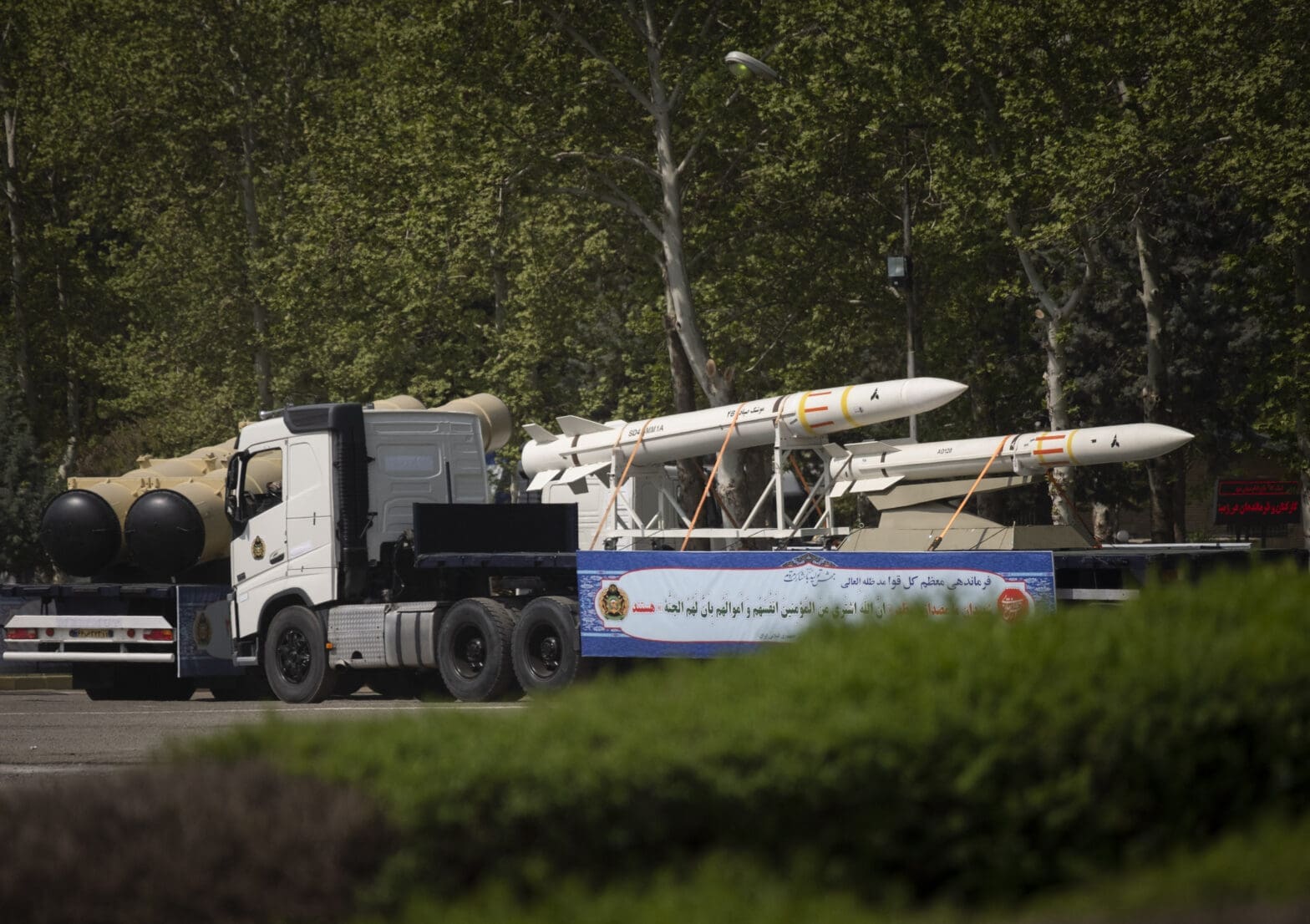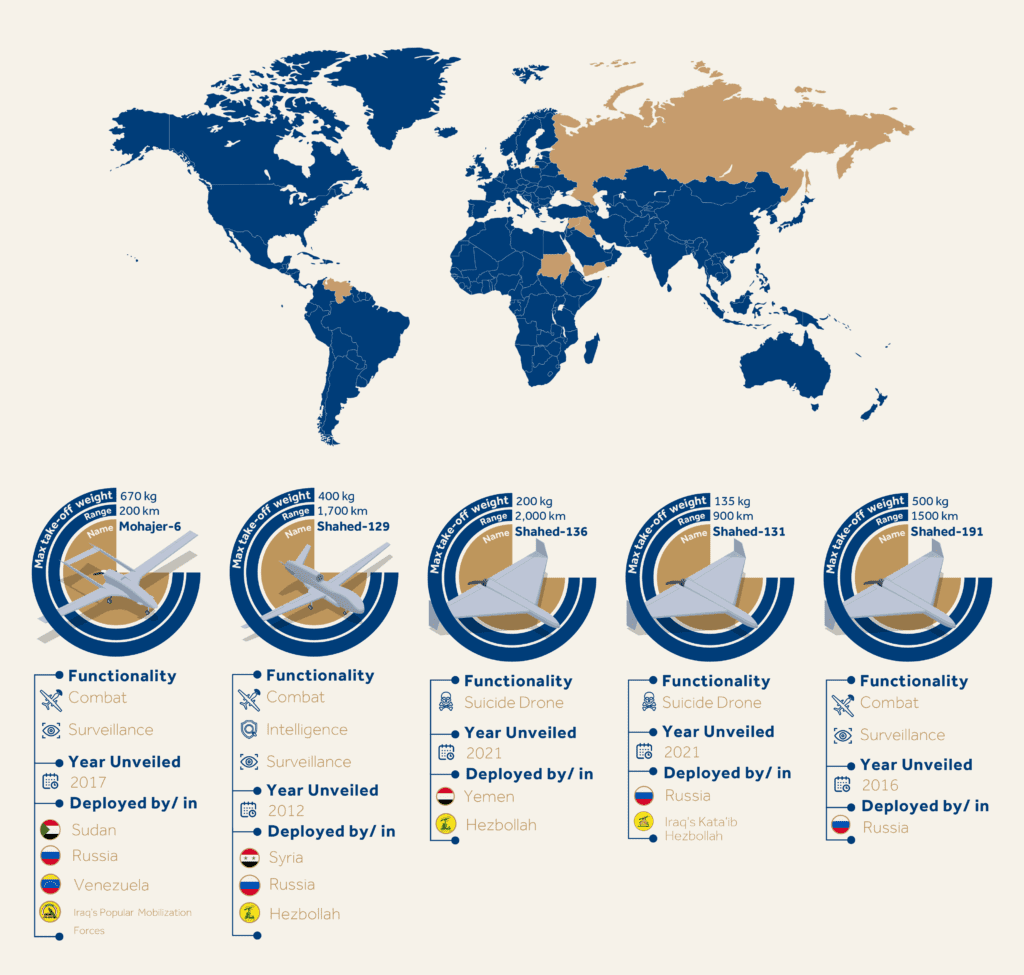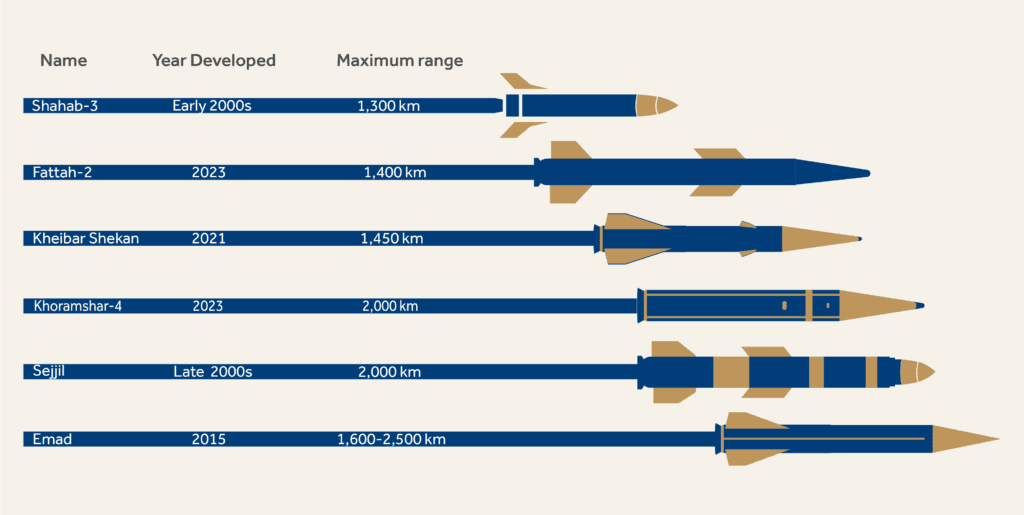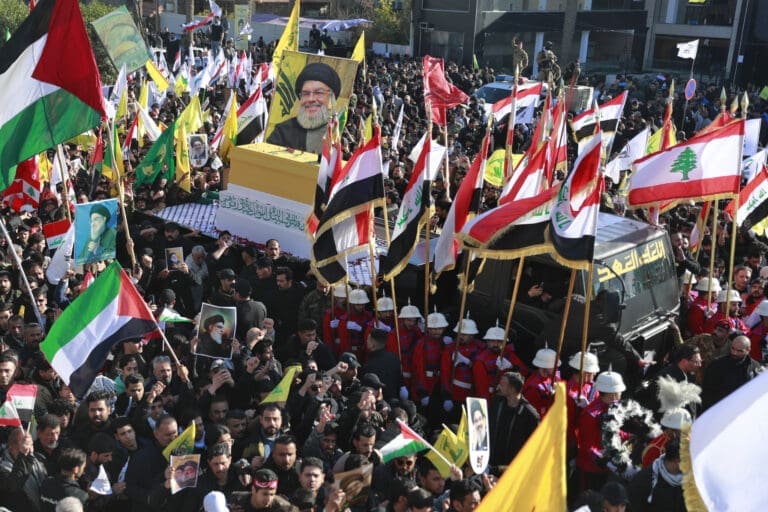
Iran’s Missile and Drone Program:
Disrupting U.S. Aerial Hegemony
Issue Brief, July 2024
Key Takeaways
Claiming the Skies: Iran views its missile and drone technology as a potent alternative to its aging air force, allowing it to project power well beyond its borders.
Bolstering Iran’s Deterrence Capacities: Missiles and drones are also part of Iran’s deterrence strategy, but their export to Russia and to various armed groups, backed by Tehran, are perceived as a source of regional instability.
Reigniting Anti-Americanism: President Ebrahim Raisi’s victory in the 2021 presidential elections consolidated political power in the hands of Iran’s conservative faction. This shift reignited anti-U.S. rhetoric in Iranian foreign policy.
A New World Order: Tehran sees drone and missile technology as a means to challenge U.S. hegemony in the Middle East and bring about a world order that no longer serves the interests of a single superpower.
Introduction
For decades, Iran has pursued a revisionist foreign policy premised on rejecting the U.S. led international order. Iranian foreign policy discourse has been underpinned by calls for a just system and opposition to the status quo. Recent global and regional events including Russia’s war in Ukraine, mass protests in Iran against authoritarian rule (which Iran blamed on the United States),1 Israel’s war on Gaza, and Tehran’s support of various groups and allies further vindicated Iran’s political thinking, hardened the leadership’s resolve, and heightened Tehran’s commitment to challenging U.S. supremacy.
Former President Ebrahim Raisi’s victory in 2021 also cemented the conservative faction’s control of the Iranian states’ key organs, complementing its hold over the legislative and the judiciary. This political synergy allowed the Raisi administration to double down on Iran’s anti-U.S. foreign policy, breaking with the strategy of his predecessor, Hassan Rouhani, who’s policies pursued a degree of rapprochement with the West.
As part of its regional and global power projection, Tehran has heavily relied on the development and use of drones and missiles. For instance, Iran showed support for Moscow, in its current war on Ukraine, by providing it with Iranian-made drones which indirectly implicates Iran in that conflict. Driven by practical and strategic considerations, the Islamic Republic has made considerable investments into the research and development of missiles and Unmanned Aerial Vehicles (UAVs or drones).2
This issue brief examines the significance of these armaments in Iran’s strategic thinking, particularly how they support Iran’s long-term objective of changing the status quo and transforming global order. It demonstrates that Iran’s strategy presents serious implications for the aerial balance of power in the region and is highly unlikely to be impacted by the deaths of President Raisi and Foreign Minister Hossein Amir-Abdollahian earlier this year.
Why Missiles and Drones?
Decades of sanctions have considerably limited Iran’s ability to maintain and modernize its armed forces, preventing the Islamic Republic from purchasing spare parts for its pre-revolutionary fleet of U.S.-made aircrafts.3 Iran’s air force is aging, seriously depleted, and reports of accidents are common.4 The deaths of Raisi and Amir-Abdollahian in an outdated Bell 212 helicopter, which was estimated to be somewhere between 40-50 years old, were a stark reminder of the state of Iran’s air fleet.5 To address this issue, Tehran has sought Russian and Chinese planes; however, these efforts have thus far not sufficiently filled the sizable gaps in Iran’s aerial capacities.
Despite challenges, Iran has rapidly developed its missile and drone technology in recent years. Iran’s pursuit of this technology is facilitated by its relative simplicity and low cost. For example, Iranian drones such as the Shahed-131 and Shahed-136 only cost around $20,000 per item, making them relatively affordable in the face of a sanctioned economy.6 Iran’s development of its missile program is also largely driven by its awareness of their devasting effects. During the Iran-Iraq war in the 1980s, Iraqi forces pounded Iranian cities with Soviet Scud missiles, even hitting Tehran, which was over 480 kilometers (300 miles) away from the Iran-Iraq border.7
In response, Iran invested in developing its missile technology, as well as importing missiles from China between 1986 and 1995. The first Chinese-made missiles Tehran obtained were the Silkworm, C-801 and C-802 anti-ship cruise missiles, and the M-7-short range ballistic missiles.8 The C-802 served as the model for the Iranian-made Nour, which has a range of 120 kilometers (75 miles), is powered by a turbojet engine, and was developed as part of a joint project between Tehran and Beijing in the early 1990s.9 Iran continued developing other models and diversifying its arsenal with short and long-range missiles. The Sejjil ballistic missile, unveiled in 2009,10 purportedly has a range of 2000 kilometers (1,240 miles), and was reportedly used in Iran’s attack on Israel earlier this year.11
Iranian drone technology also saw a boost in 2011 following the downing of an American RQ-170 reconnaissance drone that strayed into Iranian airspace from Afghanistan.12 Iranian officials boasted that the Shahed Saegheh drone, unveiled in 2016, exhibited uncanny similarities to the RQ-170, suggesting that the Islamic Republic had successfully reverse-engineered the American model.13 Since then, Iran has developed a range of drones for combat and reconnaissance. Perhaps the most familiar are its kamikaze drones, designed to carry a payload of around 50 kilograms (110 pounds) and explode on impact.14 Kamikaze drones’ effectiveness can be attributed to their precision, ability to fly at low altitude, and avoid radar detection.
Iran’s missile and drone technology has therefore allowed it to compensate for its aging air force and pose a growing aerial threat to U.S. assets in the region. While Iranian authorities affirm that these weapons aim to increase Tehran’s defense and deterrence capacities, neighboring states, such as Saudi Arabia, have voiced concern over Iran’s ability to strike targets deep inside their territory.15 Iran’s political and military leadership fueled such concerns by describing their defense doctrine as “offensive defense” or “forward defense,” a strategy centered around Iran addressing enemy threats before Iranian territory is struck. This doctrine was officially adopted in 2003 and reiterated in Iran’s parliament-endorsed Five-Year Development Plans of 2004 and 2017.16 In 2023, the seventh Five Year Development Plan also explicitly emphasized the importance of developing combat drone technology.17
The combination of a forward defense strategy, Iran’s new deterrence capabilities, and a network of regional groups that benefit from Iranian missile and drone technology jeopardize Washington’s strategic interests and assets in the region.18 This threat is recognized in Washington. At a 2021 hearing of the United States’ House Armed Services Committee on challenges to U.S. national security and U.S. military activity in the Middle East and Africa, Congressman Scott DesJarlais asserted that “as a result of the challenges faced with UAS [Unmanned Aircraft Systems] detection and interdiction… the United States is for the first time since the Korean War operating without complete air superiority.”19 General Kenneth McKenzie, former commander of the U.S. Central Command (CENTCOM), told the same Committee that Iran “continues to menace regional partners and the free flow of commerce through the use of proxies and the proliferation of armed unmanned aerial systems and other munitions. Its pursuit of regional hegemony remains the greatest source of instability across the Middle East.”20
Tehran viewed McKenzie’s statements as a vindication of Iran’s drone and missile program21 and a reflection of a new world order, led by undermining the United States’ global hegemony, emerging. Supreme Leader Ali Khamenei has maintained that “America will be isolated in the new world order.”22
Iranian Missiles and Drones in Action
Iran has also used its ballistic missiles for targeted operations. In 2018, it targeted the Islamic State (IS) in Syria, following an attack on a military parade in the Iranian city of Ahvaz.23 Mid-range ballistic missile attacks on IS bases in Syria signaled that Iran was equipped with the technology to respond to foreign threats beyond its territory.
Two years later, Iran suffered a major setback when the United States assassinated General Qassem Soleimani during his visit to Iraq. Soleimani was the former commander of the Quds Force, the Islamic Revolutionary Guards Corps’ (IRGC) outreach wing that liaises, coordinates with, and organizes paramilitary groups across the region. His assassination by a U.S. drone underscored the importance of drone technology along with its increasing use in achieving strategic objectives. This drove Iran’s efforts to enhance its own missile and drone capabilities.
That same month, Iran responded by striking the Iraqi Ain al-Assad airbase which was used by U.S. troops.24 While Iran gave prior warning of the attack to avoid inflicting causalities on U.S. troops, its response demonstrated its technological advances and reaffirmed its willingness to hit targets outside its borders. In subsequent months, Iran also used drones and missiles to attack the Kurdistan Democratic Party of Iran, an Iranian-Kurdish opposition group, in Iraqi Kurdistan.25
Earlier this year, Iran witnessed what has been regarded as “its worst domestic attack since the Islamic Revolution” when bombings killed 84 people in Kerman during a ceremony commemorating the death of Qassem Soleimani.26 The attack was attributed to IS and the Mossad.27 Tehran responded by firing ballistic missiles at targets near the U.S. consulate in the Kurdish autonomous region of Iraq which was claimed to be the Mossad’s headquarters in Erbil.28 Shortly after this attack, Iran deployed missiles and drones against a base in Pakistan that was reportedly used by Jaish Al-Adl, an armed group that has used Pakistani territory to conduct incursions into Iran.29
In the shadow of Israel’s ongoing war on Gaza, Iran once again put its missile and drone capabilities on display. In April of this year, in an unprecedented attack, it targeted Israel with more than 170 drones, 30 cruise missiles, and 120 ballistic missiles.30 This was in response to an Israeli strike on Iran’s embassy in Damascus, which killed seven IRGC officers including three senior commanders.31 Among the weapons Iran reportedly used in the attack were suicide drones Shahed-131 and Shahed-136,32 all but a handful of which were intercepted before reaching Israel.33 Iranian media also reported that the IRGC launched a Khoramshar-4 ballistic missile, which has a “range of 2,000 kilometers and is equipped with a high-explosive warhead weighing 1,500 kilograms.”34
Iranian Allies Deploy its Drones and Missiles
Iran views its drone and missile technology as a means to turn the table on its adversaries and gain a competitive edge. Iran has shared this technology with various armed groups in the region, such as Hezbollah, Hamas, Yemen’s Houthis, and numerous Shiite militia groups in Iraq. Since the start of Israel’s war on Gaza, in late 2023, these groups have used drones and missiles extensively, to target both Israel and U.S. bases in the Middle East.
The Houthis repeatedly targeted international shipping in the Red Sea with drones and missiles,35 while Hezbollah and Israel have engaged in various confrontations since October 7. The Lebanese movement has explicitly attributed its capacities to Iran. In 2016, Hezbollah Chief Hassan Nasrallah stated: “We are open about the fact that Hezbollah’s budget, its income, its expenses, everything it eats and drinks, its weapons and rockets, are from the Islamic Republic of Iran.”36
Iran-backed militia groups have also carried out more than 151 attacks on U.S. service members in Iraq and Syria since last October.37 Indeed, drone and missile models developed by armed groups across the region, through Iran’s support, have played a significant role in advancing Iran’s regional interests.
Together, Iran-backed groups’ stockpiles add up to a major region-wide arsenal. Hezbollah reportedly has more than 150,000 rockets and missiles including Iranian-made Raad, Fajr, and Zilzal projectiles.38 Examinations of technology used by the Houthis suggest that the group’s Qasef-1 drones are part of the Iranian Ababil-II family of drones.39 The Qasef-1 drone and Iranian Ababil-II drones share similar designs and the same serial number prefixes.40 Moreover, a 2020 research report by the UK based Conflict Armament Research highlighted that the Houthis have developed manufacturing capabilities to build their own drones and missiles, based on Iranian models.41
In March 2022, the Houthis put drone technology to use when they attacked Saudi oil facilities near Jeddah, more than 1,000 kilometers from the Saudi-Yemen border.42 This attack shocked the Saudi leadership and served two purposes: to remind Riyadh of Iran’s ability to strike Saudi territory and showcase that the Yemen war was not going the way Riyadh had planned. While Iran denied responsibility of the Houthi attacks on Saudi Arabia, Iranian drone technology likely made it possible.43
In Gaza, Iran has provided financial support, weaponry, and training to Hamas and the Palestinian Islamic Jihad since the 1980s.44 While it is difficult to verify the extent of this support, Iran has reportedly delivered multiple models of artillery rockets, such as Fajr-3, Fajr-5, and Badr-3 rockets, along with M-302 projectiles that were initially produced in Syria.45 Given Israel’s tight blockade of Gaza, since 2007, the volume of such transfers has probably been small and under tight controls. However, reports of Hamas’ rocket attacks on Israel in October 2024 indicate that the group has managed to leverage Iran’s technology transfers to build its own, home-made arsenal of missiles and drones.
Iran’s Drones in the Russia-Ukraine War
Russia’s invasion of Ukraine presented a new opportunity for Iran to showcase its drone technology and strengthen its relationship with Moscow. According to Khamenei, the Russia- Ukraine war heralded the “emergence of a new world order.”46 In July 2022, Jake Sullivan, White House National Security Advisor, revealed that Iran aimed to provide Russia with “up to several hundred” drones.47 In August 2022, six months into the war, it was reported that Iranian-made drones were shipped to Russia to be used in the war.48
That same year, it was also reported that Russia transported €140 million in cash and seized British and American arms to Iran in exchange for drones, mainly the Shahed-136 suicide drone, the Shahed-131 drone, and the Mohajer-6 drone.49 Since the start of the war, Russia has extensively relied on the Shahed-131 and Shahed-136 drones, which have emerged as important tools in influencing the direction of the war.50 In November 2023, satellite photos indicated progress in the building of a facility in Russia designed to manufacture Iranian-style drones in large quantities.51 For Iran, the supply of drones to Russia is viewed as part of larger efforts to undermine Washington and allow the Islamic Republic to boost its global standing.
The following figures detail some of the most important Iranian drones and missiles, based on publicly available data.
Key Iranian Drones: Characteristics and Deployment Abroad52

Mid-Range Ballistic Missiles Used by Iran in Recent Years53
Conceptualizing a “Just World Order”
Iran’s regional standing has been bolstered by the performance of its many allies, as well as by global outrage at the ongoing war on Gaza and Washington’s role in supporting and shielding Israel from accountability. Together, these are seen as vindications of Iran’s long-standing anti-American and anti-Israel posture. Khamenei has articulated this position on many occasions, highlighting the role of the “axis of resistance” and the rise of Asian powers as consequential factors in bringing about the fall of the United States.54
Even before the war on Gaza, General Hossein Salami, Commander-in-Chief of the IRGC, claimed that Iran “has changed the global scene, disrupting the order that was created by [western] powers.”55 This belief rests on confidence in Iran’s missile and drone technology, which has been a recurring theme in Iran’s official narrative. As early as 2018, Iranian authorities publicly spoke of drone and missile technology as a game-changer. General Ali Akbar Ahmadian, now Secretary of the Supreme National Security Council of Iran, argued that missile and drone technology provide Iran with a strategic advantage that could change the balance of power in the Gulf.56
Seen through this lens, the supply of Iranian drones to Russia for use in Ukraine,57 as well as to Iran’s many regional allies, is a strategic move that challenges the balance of power to the detriment of the United Sates and its allies. In 2022, the IRGC-affiliated Fars News Agency claimed that the use of drones by the “axis of resistance” would strip the United States and Israel of their conventional military advantage.58
Conclusion
The Islamic Republic of Iran has invested in missile and drone technology as part of its broader revisionist foreign policy. Tehran views its technological advances as critical to shifting the regional balance of power against the United States and Israel. Such technology, Iran’s partnership with Russia, and its patronage of sub-state actors in the region represent three pillars of a strategy to re-shape global order and herald a new era.
Moscow’s willingness to align with this strategy, opportunistic as it may be, has also emboldened Iran’s leadership. The use of missiles and drone technology by Iran-backed groups in the region has therefore confirmed to Tehran that these tools offer an effective means of challenging the United States and Israel. Iran’s missile and drone attack on Israel, in April 2024, was another demonstration of Iran’s ability to threaten Israel, as well as serving to strengthen Iran’s deterrence strategy and disrupting the United States’ aerial superiority.





